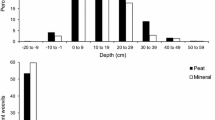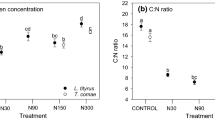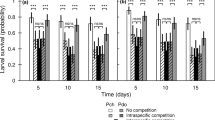Abstract
The performance of the leaf mulches ofLeucaena leucocephala, Gliricidia sepium andFlemingia macrophylla in weed control has been tested in two trials. The length of the period during which a mulch layer yields significantly less weedbiomass compared to the control plots is called the ‘effective life-span’ of the mulch.
Of the three mulch materials only that ofF. macrophylla shows promise in retarding weed development.
In the second trialF. macrophylla leaf mulch was applied at rates of 3, 6 and 9 tons dry matter per ha. The effective lifespan of a mulch layer of 3 tons is between 12 and 13 weeks. The treatments 6 and 9 tons have effective life-spans of over 14 weeks.
For moderate quantities (up to 5 tons of dry leaf mulch per ha) the effective life-span is estimated at about a 100 days.
The value of mulching in weed control is limited to the control of weed species that multiply by seed. Regrowth originating from roots or stumps from former vegetation is unlikely to be checked by a mulch layer.
Similar content being viewed by others
References
Agboola AA (1982) Gliricidia sepium: A possible means to sustained cropping in Western Nigeria. In: MacDonald LH (Ed) Agro-forestry in the African humid tropics. Tokyo, Japan (ISBN 92-808-0364-6)
Aken'ova ME and Atta-Krah AN (1986) Control of Speargrass in an alley-cropping fallow. NFTA Res Rep 4: 27–28
Anon (1964) Ann Rep Agric Res St Kade (Ghana) 1963–64. Memorandum no 3. Univ Ghana
Asare EO, Shehu Y and Agishi EA (1984) Preliminary studies on indigenous species for dry season grazing in the Northern Gunea Savanna Zone of Nigeria. Trop Grassl 18(3): 148–152
Bouharmont P (1979) L'utilisation des plantes de couverture et du paillage dans la culture du caféier ‘Arabica’ au Cameroun. Café, Cacao, Thé, 23(2): 75–100
Budelman A (in preparation). Alternatives to shifting cultivation: The use of woody leguminous perennials in yam cultivation. Department of Tropical Crop Husbandry, Agric Univ Wageningen, The Netherlands
Chadhokar PA and Sivasupiramaniam S (1983) Gliricidia leaves as protein supplement to paddy straw in growing cross-bred heifers. Indian J Anim Sc 53(2): 120–125
Clayton WD (1958) Secondary vegetation and the transition to savanna near Ibadan, Nigeria J Ecol 46(2): 217–238
IITA (1982) International Institute of Tropical Agriculture Annual Report 1982, Ibadan, Nigeria (vide p. 39)
Jordan CF (1985) Nutrient cycling in tropical forest ecosystems. Principles and their application in management and conservation. John Wiley and Sons, Chichester, UK (vide p. 12)
Kang BT, Wilson GF and Lawson TL (1984) La culture en couloirs. Un substitut d'avenir à la culture intinérante. Tech Bull, IITA, Nigeria
Lal R (1974) Soil temperature, soil moisture and maize yield from mulched and unmulched tropical soils. Plant and Soil 40: 129–143
Okigbo BN (1983) Plants and agroforestry in land use systems of West Africa. In: Huxley PA, 1983. Plant Research and Agro-forestry, ICRAF, Nairobi, Kenya
Read MD (1982) (quoted by KANG et al 1984 [11] on p 17; figure 12)
Read MD, Kang BT and Wilson GF (1985) Use of Leucaena leucocephala (Lam.) de Wit leaves as a nitrogen source for crop production. Fertilizer Research 8: 107–116
Sumberg JE (1984) Alley-farming in the humid zone: Linking crop and livestock production. ILCA Bull 18: 2–6
Verlière G (1966) Valeur fertilisante de deux plantes utilisées dans les essais de paillage du caféier: Tithonia diversifolia et Flemingia congesta. Café, Cacao, Thé 10(3): 228–235
Wade MK and Sanchez PA (1983) Mulching and green manure applications for continuous crop production in the Amazon Basin. Agronomy Journal 75: 39–45
Yamoah CF, Agboola AA and Mulongoy K (1986) Decomposition, nitrogen release and weed control by prunings of selected alley-cropping shrubs. Agroforestry Systems 4: 239–246
Author information
Authors and Affiliations
Additional information
The subject of this paper is part of a broader study, presently conducted in Southern Ivory Coast, on the production, agronomical value and use in alley-cropping systems of the species mentioned in the title of the paper. A final report is scheduled for publication in 1988.
Rights and permissions
About this article
Cite this article
Budelman, A. The performance of the leaf mulches ofLeucaena leucocephala, Flemingia macrophylla andGliricidia sepium in weed control. Agroforest Syst 6, 137–145 (1988). https://doi.org/10.1007/BF02344750
Issue Date:
DOI: https://doi.org/10.1007/BF02344750




